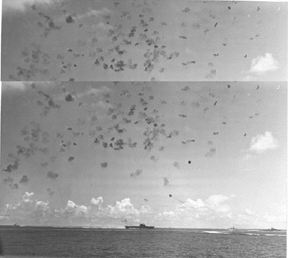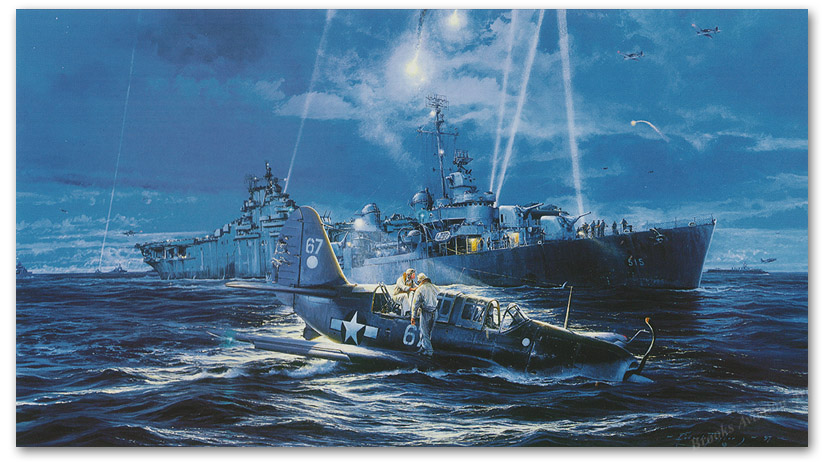The Air Battle of 20 June
Task Force 58 pushed westwards during the night of 19/20 June in order to attack the Japanese fleet, and at dawn launched air searches. On the Japanese side there was great confusion caused by the fact that Ozawa attempted to control his forces from the destroyer Wakatsuki, to which he and his staff had transferred when the Taiho had to be abandoned. The destroyer's communications were inadequate for her to act as flagship, and at about 1300 on 20 June Ozawa transferred to the large carrier Zuikaku (sister ship to the Shokaku and as of 20 June the only survivor of the six carriers which had attacked Pearl Harbor). It was only now that Ozawa learned of the massacre of his air groups the day before, and that his force had only one hundred aircraft still operational. Nonetheless he was determined to continue the battle, believing that there were still considerable numbers of Japanese aircraft operational on Rota and Guam. Ozawa intended to launch further strikes on the following day, 21 June.
American searches failed, for most of 20 June, to find the Japanese fleet, but eventually - at 1540 - an Avenger piloted by Lieutenant R.S. Nelson, from the veteran carrier Enterprise, found Ozawa's force. Nelson's message reporting the contact was however so garbled that Mitscher did not know what had been sighted or where. He nonetheless decided to make an all-out strike when more information came in, despite the fact that there were now only about 75 minutes to sunset, and that the strike would therefore have to be recovered in darkness. By 1605 further reports from Lt. Nelson had given the Task Force 58 commander the information needed.

At 1610 the aircrew manned their planes, and at 1621 the carriers turned into the wind to launch the strike, which consisted of 216 aircraft. The launching was completed in the remarkably short time of eleven minutes.
The attack went in at 1830. Ozawa had been able to put up very few fighters to intercept - no more than 35 according to the American pilots' later estimates, but these few were skilfully handled, and the Japanese ships' anti-aircraft fire was intense.
The first ships sighted by the US strike were oilers, and two of these were damaged so severely that they were later scuttled. The carrier Hiyo was attacked by 4 Avengers from the light carrier Belleau Wood and hit by at least one of their torpedoes. The carriers Zuikaku, Junyo and Chiyoda were damaged by bombs, as was the battleship Haruna. The torpedoed Hiyo later sank. Roughly 20 American aircraft were lost in this strike.
By nightfall on 20 June Ozawa had therefore lost three carriers, including two of his finest ships, and of the 430 aircraft which had been available to his force on the morning of 19 June only 35 were still operational.
Twilight was closing in as the American attack ended, and the aircrew were faced with the difficult and dangerous task of making a landing on what proved to be an exceptionally dark night. They had flown 275-300 miles to the enemy fleet and had almost as long a return flight to the US carriers. Their fuel was therefore dangerously low.

At 2045 the first returning planes began to circle over Task Force 58. Mitscher - who invariably showed unusual concern for the safety and well-being of his flyers - then took the decision to fully illuminate the carriers, despite the risk of attack from submarines and night-flying aircraft. All ships of the task force turned on their lights, and the screening destroyers fired starshell throughout the recovery, which lasted two hours. Despite these measures eighty of the returning aircraft - with pilots neither trained nor equipped for night landing - were lost, some crashing on flight decks, the majority going into the sea. But of the 209 aircrew participating in the 20 June strike 160 were rescued either during the operation or in the following few days.
The two-day engagement had been the largest pure carrier-versus-carrier battle in history, and was to be the last. The immediate consequence of the Japanese defeat was the US capture of the Marianas. This broke the Japanese inner line of defence, and meant that American bombers based in the islands could now reach targets on Japan itself. As a result of their huge losses of aircrew in the battle the remnants of the Japanese seaborne air groups were never again able to challenge the American fleet, and at the Leyte Gulf four months later the Japanese carrier force - which had once dominated the Pacific War - was reduced to playing the role of decoy, while the primary attacking role was, of necessity, assigned to the Imperial Navy's battleships and their attendant cruisers and destroyers.
Additional Sources:
www.onwar.com
www.history.navy.mil
www.brooksart.com
www.microsoft.com
www.multied.com